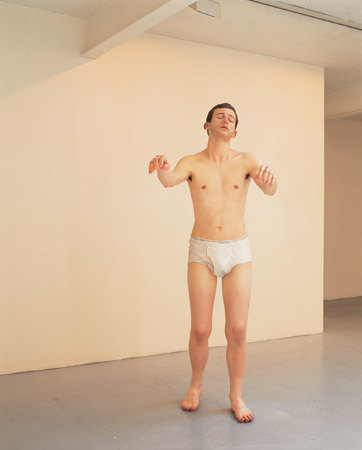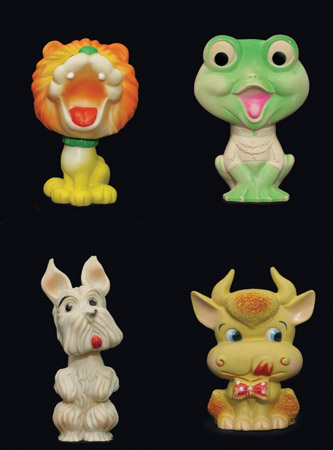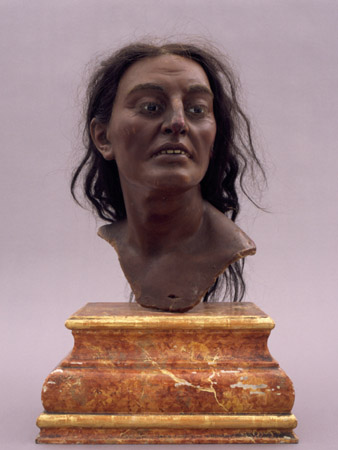MIKE KELLEY “THE UNCANNY”
HAPPENINGText: Christina Merl
Monsters can either be destroyed or exhibited. The Detroit-born artist Mike Kelley has tried both.
In the 1970s and 1980s Mike Kelley was a member of the punk band “Destroy all Monsters”, ready to revolutionise society. One decade ago, in 1993, Kelley organised the exhibition “The Uncanny” for “Sonsbeek” in the Netherlands. On the occasion of this exhibition the artist published an essay entitled “Playing With Dead Things”, in which he referred to a treatise by the Viennese psychotherapist Sigmund Freud. The “Uncanny”, as described by Freud, is “a hidden, familiar thing that has undergone repression and then emerged from it”. It is an irritating emotion filling us with anxiety – what used to be well-known suddenly becomes terrifying.

Mike Kelley, Sleepwalker, 1997, Polyester und Farbe, 165 x 51 x 76 cm, Collection Berkley Trust, London, Photo: Tony Matelli, Courtesy of Andrehn-Schiptjenko, Stockhol
Freud’s monsters derive from our ‘doubt about whether an apparently living being has a soul, and, on the contrary, ‘whether a lifeless object might have a soul’. Kelley’s initial inspiration for his exhibition had been a stay in Vienna. It was in this city that the American artist encountered intriguingly strong contrasts and the lingering morbidity of the late 19th century that seemed to persist in an atmosphere of all-pervasive ambiguity and eccentricity. Therefore, Kelley incorporated objects taken from several “uncanny” Viennese locations in the show, including wax specimens of a mental institution and objects from an old amusement park.

Mike Kelley, Harem #1, Squeeze toys, Photo: Lisa Rastl, Courtesy Mike Kelley, Los Angeles
This year has seen a remake of Kelley’s show for the Tate Gallery in Liverpool. The exhibition is now presented in Vienna’s MUMOK. In a highly original manner, uncanny figurative representations are related to each other in a sweeping historical panorama, ranging from ancient Egyptian grave furnishings to works created by contemporaries such as Christo, Paul McCarthy, Tony Oursler and others. The spectacular section of sculptures is complemented by Mike Kelley’s own collection – “The Harems”. These consist of 15 different object types which the artist associates with his childhood and adolescence, ranging from marbles and toys to hundreds of bubble gum cards, postcards, record covers, magazines and church banners. “The Harems” comprises objects typical of our consumer societies, and it is by accumulating and standardizing their presentation that their “uncanny aura” is disclosed. Kelley’s sculptures demonstrate the fragility of the human body; evolution’s protection mechanisms; the ugly and the deformed; and, finally, death. The puppets replace human beings and even outlive them – they outlive them because they had never actually lived.

Mike Kelley, Kopf eines Indianerhauptlings aus Prauschers Panoptikum im Wiener Prater (gegrundet 1872) Wachs bemalt Kunstkammer Georg Laue, Munchen © Photo: Margret Schuetzeneder
From 17th July to 12th August, a film festival took place on the subject of “The Uncanny” in the Vienna Filmcasino and the Filmmuseum Wien. On 16 evenings an extensive film programme was shown, ranging from expressionist films of the 30s to classical horror and splatter films such as Frankenstein (James Whales, 1931), Meshes of the Afternoon (Maya Deren, 1944), Eraserhead (David Lynch, 1978), Re-Animator (Stuart Gordon, 1985), Dead Ringers (David Kronenberg, 1988), Henry: Portrait of a Serial Killer (John McNaughton, 1990) and others.
Mike Kelley “The Uncanny”
Date: 17th July – October 31st, 2004
Place: MUMOK
Address: 1 Museumsplatz, A-1070 Wien
Tel: +43 1 525 00
info@mumok.at
https://www.mumok.at
Text: Christina Merl
Photos: Courtesy of MUMOK © Mike Kelley





